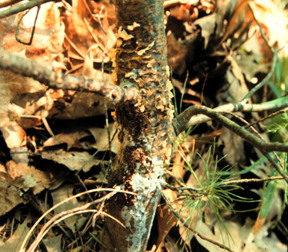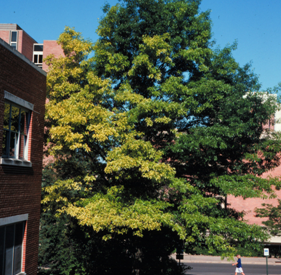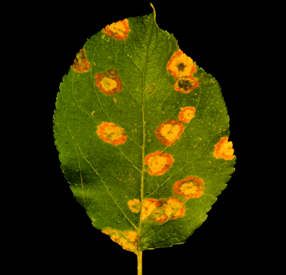
What is white pine blister rust?
White pine blister rust is a serious, tree-killing disease of eastern white pine and its close relatives (pines with needles in bundles of five). This disease is caused by the exotic (non-native) fungus Cronartium ribicola, which was introduced into North America in the early 1900’s. This pathogen is now found in most regions where pines grow in the United States, including Wisconsin. White pine blister rust affects trees of all ages, but perhaps most frequently and severely damages seedlings and saplings.
Where does white pine blister rust come from?
White pine blister rust is caused by the fungus Cronartium ribicola, which requires two different plant hosts to complete its complex life cycle. Spores of the fungus produced on white pine are blown to alternate host plants in the genus Ribes (gooseberries and currants). After infecting gooseberry and currant bushes the fungus multiplies rapidly throughout the summer, repeatedly producing spores that germinate to result in additional gooseberry and currant infections. Spores produced in late summer on gooseberries and currants are spread by the wind to white pines, where needles that are moist from rain, fog, or dew are infected.
What does white pine blister rust look like?
Infection of needles by Cronartium ribicola results in development of yellow to brown spots and bands. The fungus slowly grows through pine needles and bark to eventually form cankers on twigs, branches, and trunks of trees. A canker is a localized diseased area (either swollen or sunken) that is surrounded by healthy tissues. A typical white pine blister rust canker has resinous margins, and may appear “blistered” before rupturing to expose fruiting bodies (reproductive structures) with yellow to bright orange spores of Cronartium ribicola. As a canker expands to completely encircle stems, all parts of the plant beyond the canker are killed. Dead white pine branches may temporarily retain their orange to red dead needles to form a bright “flag” that is a common symptom of this disease.
Can I save a tree affected by white pine blister rust?
There is no “cure” for a tree with a white pine blister rust canker on its main trunk or stem. As the canker expands to completely encircle the trunk, all parts above the canker will die. Branch cankers that extend to within four inches of the trunk, probably indicate that the trunk already is colonized by the fungus and future development of a main stem canker is likely. Pruning off branches on which cankers are located farther from the trunk, however, can prevent the fungus from growing into the trunk. These branch cankers can be removed by pruning at least six inches beyond any visible symptoms on the trunk side of the cankered branch. Removal of branch cankers and trees with main stem cankers prevents production of spores that are spread to gooseberries and currants. The fungus quickly dies in discarded branches and trunks and presents no further danger to either of its hosts.
How do I avoid future problems from white pine blister rust?
Infection of pine is most frequent near diseased gooseberries or currants. Therefore, removing these plants (especially within 200 feet) can greatly reduce the incidence of white pine blister rust. Gooseberries or currants can be killed by uprooting them or by application of herbicides in accordance with label directions.
Conditions that promote or prolong needle wetness should be avoided. These include use of sprinklers that wet the needles of ornamental trees, dense plantings, growth of weeds surrounding young trees, or planting white pines in low-lying, chronically moist areas near water or sites that lack good air movement. Growing white pines under a hardwood overstory that will intercept evening dew can help keep needles dry and reduce infection.
Regular inspection allows prompt detection and removal of cankered branches on young trees. Also, because infection very often occurs on needles of low branches, pruning to remove healthy branches (if aesthetically acceptable) will reduce the likelihood of this disease. When trees are five to seven years old, starting close to the ground, prune off all branches up to no more than one-third to one-half the height of the tree. Branch pruning can be continued every other year until the lower eight to nine feet of trunk is free of branches.
Planting or measures to encourage natural regeneration of conifer species other than white pines (including red or jack pines, spruces, firs, arborvitae, hemlock, and junipers) might be considered, especially where gooseberries or currants are prevalent and where moisture conditions favor infection.
Application of protectant fungicides may be a useful management practice in white pine production nurseries. Nursery stock should be carefully inspected, particularly just prior to sale, because the planting of diseased white pine seedlings is one way Cronartium ribicola has been spread into previously disease-free locations.
For more information on white pine blister rust:
Contact the University of Wisconsin Plant Disease Diagnostics Clinic (PDDC) at (608) 262-2863 or pddc@wisc.edu.
Authors: Joseph Schwartz, UW-Madison Forest Ecology and Management and Glen R. Stanosz, Ph. D., UW Madison Plant Pathology
Last Revised: 03/02/2024
D-number: D0126
References to pesticide products in this publication are for your convenience and are not an endorsement or criticism of one product over similar products. You are responsible for using pesticides according to the manufacturer’s current label directions. Follow directions exactly to protect the environment and people from pesticide exposure. Failure to do so violates the law.
Thanks to Ann Joy and Brian Hudelson for reviewing this document.
A complete inventory of UW Plant Disease Facts is available at the University of Wisconsin-Madison Plant Disease Diagnostics Clinic website: https://pddc.wisc.edu.
Send a Plant Sample for Analysis
Be cautious when self-diagnosing plant health issues. Very few diseases can accurately be diagnosed by eye.
Contact the UW Plant Disease Diagnostics Clinic (PDDC), and for a small fee, clinic staff can examine a plant, determine the cause of the disease/disorder, and provide advice on how to control or prevent the issue.
Download Article





 Chlorosis
Chlorosis Conifer Disease Quick Reference
Conifer Disease Quick Reference Gymnosporangium Rusts (Cedar-Apple Rusts)
Gymnosporangium Rusts (Cedar-Apple Rusts) Ips Bark Beetle
Ips Bark Beetle


